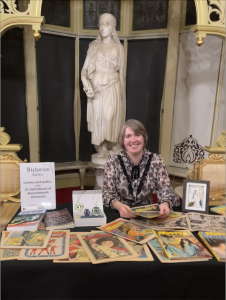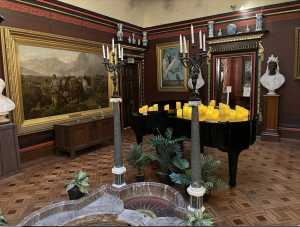The Russell Cotes Museum Late evenings are a chance to explore the museum after dark with short talks and pop-up exhibitions – a perfect opportunity to talk about Gothic at a sold-out event.
I’d been invited to set up a stall exploring Gothic Comics, showcasing my research into British girls’ comics of the 1970s. This let me share lots of comics alongside the free gifts that were given away with the first few issues of each new title. I also brought along a few very rare items such as the dummy folder of the launch issue of Misty #1, which shows how story titles were added in (letraset transfers) and colour pages were allocated.

It was a brilliant evening where I found myself set up alongside tarot readings, Gothic poetry writing, a handling table of memento mori objects from the museum, and lots of short talks and readings of classic Gothic literature, all set to candle-lit piano music.

I had a great time chatting with some fabulously dressed folk about the largely forgotten wave of Gothic girls’ comics that emerged in Britain in the 1970s and how they used many common motifs of the Gothic tradition (embedded stories, nature imagery) and Victorian Gothic themes and settings (Jack the Ripper, Dracula, dire workhouses, wicked governesses, seances, and more). I always love getting people to reminisce about the comics they remember (or have mostly forgotten) and this was no exception! We talked about the way these comics were produced (small teams, weekly outputs, a frantic pace), the reasons they’ve been lost to memories and history (greedy publishers, competition with other media, poor treatment of creators and readers), the gothic tropes and themes they contain (adaptations of everything from Edgar Allan Poe to Stephen King, modern cautionary tales, myths and legends, historical ghost stories), and the balancing line they tread between conservative morals and transgressive excitement.
To find out more about this lost gothic, please visit my website www.juliaround.com.
Julia Round is an Associate Professor and English and Comics Studies in the Department of Humanities and Law, and Head of the Narrative, Culture and Community Research Centre. She has over 50 publications on Gothic, horror and comics, including the award-winning book Gothic for Girls (2019).











 Writing policy briefs
Writing policy briefs Upholding Excellence: The Concordat to Support Research Integrity
Upholding Excellence: The Concordat to Support Research Integrity Today’s Documentation Will Serve Tomorrow’s Justice
Today’s Documentation Will Serve Tomorrow’s Justice Up2U: New BU academic publication
Up2U: New BU academic publication New BU midwifery paper
New BU midwifery paper ECR Funding Open Call: Research Culture & Community Grant – Application Deadline Friday 12 December
ECR Funding Open Call: Research Culture & Community Grant – Application Deadline Friday 12 December MSCA Postdoctoral Fellowships 2025 Call
MSCA Postdoctoral Fellowships 2025 Call ERC Advanced Grant 2025 Webinar
ERC Advanced Grant 2025 Webinar Horizon Europe Work Programme 2025 Published
Horizon Europe Work Programme 2025 Published Horizon Europe 2025 Work Programme pre-Published
Horizon Europe 2025 Work Programme pre-Published Update on UKRO services
Update on UKRO services European research project exploring use of ‘virtual twins’ to better manage metabolic associated fatty liver disease
European research project exploring use of ‘virtual twins’ to better manage metabolic associated fatty liver disease